Abstract
Artificial turf provides a consistent and durable surface; however, it has historically been associated with a high skin injury risk, or a ‘friction burn’, when a player falls or slides. Second-generation surfaces feature a short carpet pile, whilst third generation (3G) carpet piles are longer, enabling the integration of a performance infill. 3G surfaces provide sufficient energy absorption characteristics to be approved as Rugby Turf; however, such pitches can still cause skin injuries, despite being assessed using a friction-based test. Reducing skin injury risk motivates this study to develop a more sensitive testing methodology. A new test apparatus and impactor are proposed, achieving kinematics representative of an elite male rugby tackle. A commercially available skin simulant is employed to ensure the collection of repeatable and valid data. Photography and thresholding were used to assess surface abrasion and material transfer, whilst a thermal camera captured surface temperature change. Accelerometers quantified the surface resistance during the impact and sliding phases. These metrics were compiled into the Maxwell Tribo Index (MTI), providing a single measure of skin injury risk. The results demonstrated good repeatability and validity when four teams tested four different 3G surfaces. These results compared favourably to an expert panel’s ranked order.
1. Introduction
Synthetic surfaces aim to provide a playing experience comparable to an elite natural turf, whilst achieving high durability. First generation synthetic surfaces adopted a short-pile carpet laid on an asphalt base, whilst the second generation (2G) included a shallow infill or dressing material (e.g., sand). Whilst achieving enhanced ball behaviour, the abrasive constituents meant both generations were associated with high skin injury rates [1]. Third generation (3G) synthetic surfaces are laid upon a shock-absorbing pad and have a longer carpet pile length to incorporate sand ballast and a performance infill, typically granulated styrene butyl rubber (SBR). The capacity for greater SBR infill means that 3G surfaces typically satisfy the additional energy absorption demand that is required for classification as Rugby Turf [2,3,4].
Seven and a half million people in 128 countries are registered rugby players, meaning it is one of the most popular global sports [5]. Rugby is typically played on natural grass pitches; however, Rugby Turf is increasingly recognised to provide longer playing time, reduced maintenance costs, and consistent playing conditions [6]. More than seven hundred Rugby Turf pitches have now been accredited, including within elite clubs and for use in international competitions. Such activities continue to drive forward the global synthetic surfaces market, worth USD 3 bn (2022) and projected to reach USD 5.4 bn by 2028 [7].
Skin provides a protective barrier against external environmental threats; however, it is susceptible to traumatic injury when exposed to energy that exceeds its inherent mechanical properties, including stiffness and strength. The precise injury mechanism is influenced by factors such as magnitude of load, orientation, and velocity [8], with acute wounds including blisters, lacerations, and contusions. Abrasive ‘friction burns’ (or ‘turf burns’) were synonymous with early generation pitches, with superficial skin layers removed when players slid or fell onto the surface [9,10]. Third generation surfaces have reduced injury incidence; however, these still pose an inflated risk compared to natural turf [11,12]. Williams et al. [11] reported that skin injury risk was almost eight times higher on synthetic surfaces when surveying elite male 15-a-side rugby. Sevens rugby, a faster-paced variant, may represent an even greater risk, with unpublished data indicating a further 10-fold increase in injury rates when compared to 15-a-side. ‘Turf burns’ typically damage the superficial skin and expose nerve endings, a different aetiology to thermal-related burns (e.g., from domestic accidents) that damage multiple skin layers [13,14,15,16]. Indeed, combined with a lack of evidence to support a significant temperature increase, a turf burn appears more likely to be a turf abrasion.
Every player–surface interaction involves different velocities, loads, and sliding directionalities, as well as skin, surface, and surface conditions, all of which produce a unique injury risk. Past studies have been unable to isolate factors that are especially injurious, partly limited by a lack of sensitive testing methodologies. Systematic, laboratory-based studies using human volunteers allow only limited investigation due to the need to avoid trauma. Skin simulants provide a route to achieving consistent performance without concern for injury. Chamois leathers and nylon stockings have previously been reported, in addition to polyurethane-coated polyamide microfibre fleeces (e.g., commercial products including ‘Lorica Soft’), with similar roughness to dry skin [17,18,19,20]. The current skin-surface testing standard is defined by the Securisport test, which approximates risk by calculating the relative friction of different surfaces versus a silicone-covered steel anvil moving in a circular sweeping action. This lacks bio-fidelity by using relatively slow sliding velocities and loading rates [21] and producing unrealistic infill displacement and pile flattening. A new system is now needed to better quantify skin injury risk on synthetic surfaces [22].
Accurately simulating skin injuries requires an understanding of player kinematics. With over 75% of rugby players being male and experiencing higher injury rates compared to females, men are most often injured [5,23]. Elite male rugby players average 108 kg and 1.87 m [24]. Tackling is the greatest contributor to player–surface contacts in rugby [25]; however, scant data exist to describe the associated biomechanics. Drawing comparison to soccer, players performing slide tackles generated knee and hip ground reaction forces of 3.0 to 6.4 times their body weight (BW) (2.3 and 4.9 kN), with lower shear forces (1.4 kN and 1.8 kN, respectively) [26]. Diving goalkeepers generated 3–8 kN ground reaction forces, with studies describing falls within a laboratory environment reporting 4.2–8.6 BW increases [27].
This study now describes the development, repeatability, and validity of a new apparatus to quantify skin injury risk, assessed using the new Maxwell Tribo Index (MTI) metric. Success provides a platform for the sector to enhance player welfare.
2. Materials and Methods
2.1. Materials
A dearth of scientific literature motivated additional searches to identify the most ‘at-risk’ group of athletes, plus the anatomical location and kinematic data that were most frequently associated with skin injuries on synthetic surfaces.
2.1.1. Apparatus Kinematics
A social media search was performed (September 2021) adopting the terms skin abrasion; rugby burn; turf burn; friction burn; and Astro burn. This identified the knee and tibial shank as the anatomical region most frequently associated with skin injury, following participation on a synthetic surface. Injuries were most often reported by elite male athletes, although such a search strategy is inherently biased towards this group, given that they currently outnumber their female counterparts and have more prominent profiles than amateurs. Additional ‘live’ data were captured that corroborated the most frequently injured location and that such injuries typically occur during a tackle. Whilst injury rates are comparable, absolute skin injury numbers are greater in the male cohort, the larger playing population. Elite male athletes sprint up to 10 ms−1, though the tackling of a player anecdotally reduces their speed to an estimated 5 ms−1 [28,29].
2.1.2. Apparatus Design
The apparatus focused on the knee and tibial shank and the impacting force of an elite male rugby player. Knee anthropometric data corresponding to an average elite male rugby player were adopted from an online database [30], which enabled the development of a computer-aided design file. The knee-form impactor was fabricated using additive manufacturing and polyamide 12, with a wall thickness of 4 mm. Additional rigidity was achieved by filling the hollow impactor with epoxy resin. Design features were added to ensure that the impactor could be covered with a taut, synthetic skin. The 95th percentile popliteal height was selected to represent the knee height, meaning the impactor would fall 0.5 m, with the tibial shank broadly horizonal to the surface on impact [31]. Adopting a static pose on a force plate indicated 25–40% BW is transferred through each knee when tackling (unpublished data). Velocity changes through impact and sliding were captured by two single-axial (horizontal = 100 g, vertical = 200 g) accelerometers (Differential MEMS DC accelerometer; Model 3741F; PCB Piezotronics Inc., Depew, NY, USA), mounted at the impactor’s centre of mass.
The apparatus (Figure 1) was fabricated to straddle surfaces with minimum dimensions 2.5 m (l) × 0.9 m (w), to ensure compatibility with existing test methods (FIFA Test Method 15 [32]). In brief, parallel rails were securely attached to a rigid frame (0.6 m (h) × 0.5 m (w) × 6 m (l)), to guide a carriage. The 160 kg carriage was attached to the rail using low-friction roller bearings and was then accelerated via a linear induction motor to 5 ms−1. The 36 kg knee impactor was coupled to the carriage via an electromagnetic system, which allowed for instantaneous release under guided freefall to ensure it remained parallel to the surface. Anatomical and physiological energy absorption was simulated using rubber dampeners, ensuring the knee impactor rebound was visually consistent with ‘real-life’ player–surface interactions.
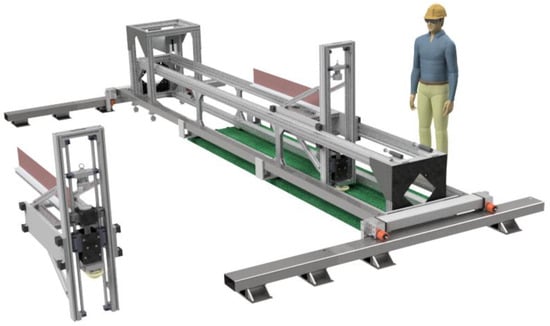
Figure 1.
Assembled components showing the impactor being held on a vertical rail for guided free fall and then incorporated into the rig, which enables accurate simulation of an elite male rugby player interacting with a surface. A 1.80 m mannequin provides some dimensional context.
2.1.3. Skin Simulant
The skin simulant for the Securisport, the current industry standard for assessing skin abrasions of artificial turfs, has limited suitability for this testing as its frictional performance is significantly different from that of ex vivo human skin samples; therefore, an alternative skin simulant is required [33]. Whilst human skin condition will vary due to various factors (genetics and body composition, environmental factors, and lifestyle), adopting a single, commercially available product was prioritised, given the need to ensure consistent and repeatable testing. Lorica Soft, a polyurethane-coated polyamide microfibre fleece, is widely reported in the tribology literature as accurately and consistently representing dry skin [17,34,35].
2.1.4. Skin Temperature
Lorica Soft’s low thermal conductivity caused inaccurate data when attempting to indirectly capture surface temperature change via underlying thermistors. Instead, peak surface temperature was captured immediately after each test using a thermal camera mounted to the apparatus. A region of interest was defined along the surface length, with a 0.1 m width that was consistent with the maximum contact dimension. The mean peak temperature (TP) was then computed following five tests.
2.1.5. Skin Abrasion
The uppermost skin simulant layer is red, with a white underlying microfibre layer; hence, a change in colour across a fixed area provides a measure of abrasion that can be compared across different interactions. Quantifying the extent of change was aided by adopting FIFA’s Test Method 16, which utilises a grayscale thresholding technique to quantify the density of infill splash [36]. This procedure inspired the development of an objective assessment to quantify the abrasion generated on the skin by producing filtered ‘negatives’ of the original photograph (Figure 2). Preliminary testing indicated that some synthetic surfaces could abrade through the entire thickness of the skin simulant, whilst some material transfer from the infill was likely to darken some focal regions of the synthetic skin. Microscopic analysis highlighted that this darkened perimeter appeared smoother than the lighter areas. These two regions were evaluated independently, as they were anticipated to produce different magnitudes of pain.
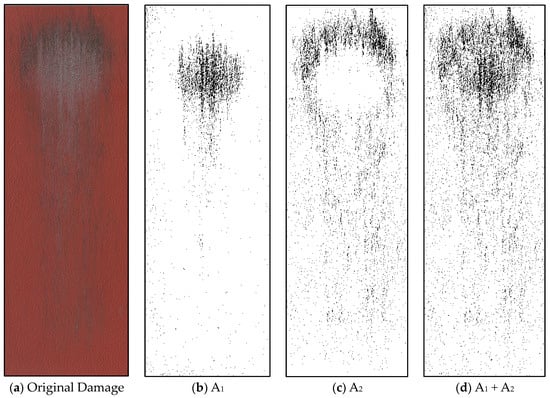
Figure 2.
The methodology adopted to quantify ASI. (a) Representation of the original skin damage; (b) representation of the abrasion zone, A1; (c) representation of the transfer zone, A2; (d) combination of the abrasion and the transfer zone.
A stopband filter was applied to remove red, with the thresholds identified by evaluating fresh skin simulant samples. The grayscale histogram was evaluated, forwards and backwards from the peak, to establish the intensity index when the gradient was less than the initial index.
Skin damage assessment from preliminary testing highlighted that peak intensity varied with infill material. A high-pass filter (threshold = peak grayscale intensity + 17) defined the abraded area (‘A1’), before a second low-pass filter (threshold = peak grayscale intensity − 15) defined the darkened area associated with material transfer (‘A2’). This darkened perimeter was consistent with skin injuries and was generally associated with less severe trauma; hence, A2 was given half the weight of A1. To ensure that abrasion was quantified consistently across all surfaces, a coefficient was included to capture any sliding that was prevented by the apparatus length. This coefficient represents the ratio of expected sliding distance (dE) based on horizontal sliding speed derived from accelerometer data to actual sliding distance (dA) and is combined to create the Abrasion Severity Index (ASI; Equation (1)).
Figure 2 presents an example dataset and the associated ASI. The original photograph (Figure 2a) demonstrates zones of abrasion (white) and, in black, rubber infill transfer. The abrasion (Figure 2b) and transfer (Figure 2c) zones are then isolated before being summated (Figure 2d) as per the ASI ratio.
2.1.6. Surface Resistance
Quantifying the surface resistance represents the deceleration during impact and sliding phases.
- Surface Impact Resistance (Ri)
The impact zone is the initial contact with the surface. Ri is defined by the peak horizontal deceleration, as recorded by the impactor-mounted accelerometers. This initial skin–surface contact is expected to be of short duration and involves only minimal horizontal translation as the impactor rebounds off the surface. Surfaces expected to generate high Ri are typically ineffective at absorbing energy, including those with less infill (e.g., 2G) and 3G surfaces where the loose infill may be bound together (e.g., areas contaminated with soil, a combination of infill material and shape). A high Ri is likely to produce high contact stresses within the skin and soft tissues, which is hypothesised to cause greater skin injury risk.
- Surface Sliding Resistance (Rs)
The sliding phase is a protracted slide with the impactor in constant contact with the surface. Rs is the average deceleration during the sliding phase, derived from the dedicated accelerometer. This motion is predominantly horizontal, so the impactor will have relatively low surface resistance.
2.1.7. Maxwell Tribo Index (MTI)
The MTI (Equation (2)) combines the above parameters to provide a single metric that characterises the relative skin injury risk posed by different synthetic surfaces. The weighting for each parameter was tuned using preliminary data generated by testing a multitude of 2G, 3G, and fourth generation (non-infill) surfaces. TP is presented relative to a 44 °C threshold, which defines the temperature required to burn the basal skin layer [37]. The ASI is normalised to 1750, which was deemed to appropriately reflect the abrasion variation observed across the different test samples. Ri and Rs were normalised to the peak values recorded during preliminary testing, thereby representing a worst-case scenario. These metrics are captured across 5 tests using the same skin sample to achieve greater sensitivity when assessing each synthetic surface. Each test is performed on a freshly prepared surface, with the results combined to form the MTI (Equation (2)).
2.2. Methods
Four operative teams (Teams 1–4), each comprising 2–3 employees from an established surface testing facility, were trained to use the new device. Each team assessed 4 synthetic surfaces (Surfaces 1–4). Device repeatability was quantified by comparing the 4 assessments of the same surface. Device validity was quantified by comparing the mean scores of each surface to those of an expert panel.
2.2.1. Synthetic Surface Samples
Four 3G synthetic surfaces were constructed to investigate the validity of the new apparatus. Each ‘carpet’ (comprising the green pile) was cut to fit the specified dimensions (4 × 1 m), with the drainage holes sealed to prevent infill leakage. Carpets were then secured to a 10 mm deep prefabricated shock pad. Two carpets had a 60 mm pile length. Both were filled with sand to a 20 mm depth, before adding a further 20 mm of rubber (‘Surface 1’) or cork (‘Surface 3’). The other two surfaces had a 45 mm pile length and were filled with 20 mm of sand, then 15 mm of rubber (‘Surface 2’) or cork (‘Surface 4’). Each surface was then pre-conditioned by performing 5 cycles with a 90 kg studded roller (FIFA Test Method 15 [32]). Infill depths were then measured at three equidistant locations across the width and along the length, producing 18 datapoints per surface.
2.2.2. Expert Survey
To investigate MTI validity, ten synthetic surface experts were presented with the technical specifications and photographs of the four compositions and were asked to rank them based on the likely skin injury risk. An expert was defined as someone with at least 5 years’ experience within the 3G synthetic surface sector. Experts were blinded to each other and to the data from the apparatus. The final ranked order was determined by calculating the mean score for each surface.
2.3. Statistical Analysis
Statistical analysis assessed repeatability across the 4 teams and then across the 4 surfaces. A Shapiro–Wilk test was conducted to assess the normal distribution of each metric. Based on these results, either a parametric test (one-way analysis of variance (ANOVA)) or a non-parametric test (Kruskal–Wallis test) was chosen. Following the ANOVA test, post hoc Tukey’s t-tests were conducted for further analysis. All statistical analyses were performed using SPSS, adopting a significance threshold of p < 0.05.
3. Results
3.1. Synthetic Surface Compositions
Four 3G synthetic surfaces were constructed to investigate the repeatability and validity of the new apparatus. The mean thickness of each constituent is described in Figure 3. The standard deviation was less than 0.18 mm across all measurements.
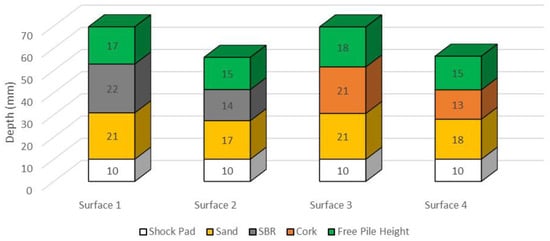
Figure 3.
Mean constituent depth of the four 3G synthetic surfaces that were constructed to measure testing repeatability and validity.
3.2. Reliability Testing
3.2.1. Mean Peak Temperature, Tp
The temperature measurements were acquired by a mounted thermal camera, collecting data along the slide length. The median temperatures range from 24 °C to 28 °C across the four surfaces (Figure 4), with the interquartile range greatest for those using cork infill (Surfaces 3 and 4). The 60 mm pile carpet recorded the highest median value, whilst the shortest recorded the greatest variation in all surfaces. A Shapiro–Wilk test confirmed a non-normal distribution (p < 0.05), and a Kruskal–Wallis test assessed repeatability (the same surface measured by different teams) and validity (when combined to form the MTI, as compared to the expert panel). Supplementary Table S1 describes strong repeatability across all measures, and Supplementary Table S2 highlights a statistical difference between surfaces.
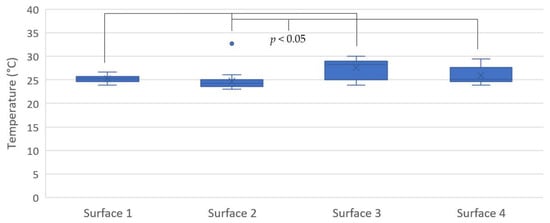
Figure 4.
Tp reported from 20 tests on each surface. The median temperature ranged from 24–28 °C across the four surfaces, with the interquartile range greatest for the surfaces using cork infill (Surfaces 3 and 4). All surfaces were statistically different except for Surface 1 and 4.
3.2.2. Abrasion Severity Index, ASI
The ASI is calculated as per Equation (1), combining the abrasive wear on the Lorica Soft sample with areas of infill material transfer. The ASI magnitudes were significantly different between the cork (Surfaces 3 and 4) and SBR (Surfaces 1 and 2) surfaces (Figure 5). The variation in data was low, except for the long-pile cork surface, which had the greatest interquartile range. The lack of outlying data does, however, indicate relatively high repeatability across each of the 20 tests. The ASI score per surface (Supplementary Table S1) represents the wear accumulated over five tests, though it limits statistical analysis. Supplementary Table S2 demonstrates that cork infill yielded significantly higher ASI scores (p < 0.05) compared to SBR infill.
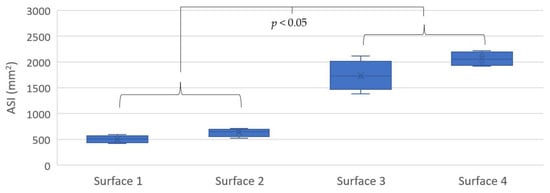
Figure 5.
ASI reported from 20 tests on each surface. Magnitudes varied significantly between SBR (Surfaces 1 and 2) and cork (Surfaces 3 and 4).
3.2.3. Surface Resistance during Impact, Ri
The variation in Ri highlighted how the impactor experienced resistance to sliding during the initial contact (Figure 6). A Shapiro–Wilk test confirmed a normal distribution (p > 0.05). Consequently, an ANOVA test was conducted to assess repeatability among the teams and across the four surfaces. Supplementary Table S2 shows that Team 3 produced less repeatable results; however, despite this variability, Tukey’s post hoc tests detected significant differences across all surfaces (Figure 6, Supplementary Table S2). Surface 2 reported the greatest range in data, whilst the other short-pile carpet, Surface 4, had the greatest range among those with cork infill. This is possibly caused by the impactor penetrating the relatively thin layer of infill, engaging with the underlying sand and potentially causing it to ‘plug’ like a golf ball landing on soft ground, thus causing a more rapid deceleration.
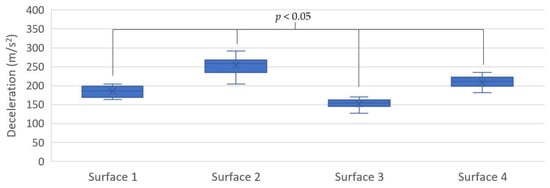
Figure 6.
Ri reported from 20 tests on each surface. Cork (Surface 3 and 4) exhibited lower impact decelerations than SBR (Surface 1 and 2). Concurrently, additional performance infill (Surface 1 and 3) reduced surface resistance. All surfaces were statistically different.
3.2.4. Surface Resistance during Sliding, Rs
Rs is much lower than Ri, which is considered a positive attribute of 3G surfaces (Figure 7). High deceleration would indicate an abrasive interaction, potentially caused by a ‘locked’ infill and carpet pile or when testing early-generation surfaces, which have a very thin infill layer, causing abrasion against the very short (~10 mm) carpet pile. The interquartile ranges indicate that this method acquired repeatable data, except for some outliers associated with the cork surfaces. A Shapiro–Wilks test confirmed a non-normal distribution (p < 0.05). Subsequently, a Kruskal–Wallis test was conducted to assess variation across the teams and surfaces. Supplementary Table S1 demonstrates repeatable data were generated across most surfaces, whilst Supplementary Table S2 again highlights statistical differences between surfaces.
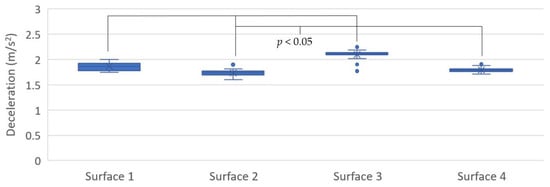
Figure 7.
Rs reported from 20 tests on each surface. SBR (Surface 1 and 2) exhibited lower slide resistance than cork (Surface 3 and 4). Concurrently, additional performance infill (Surface 1 and 3) increased surface resistance. All surfaces were statistically different except for Surface 1 and 4.
3.2.5. Maxwell Tribo Index, MTI
The MTI weights and then summates the above parameters as per Equation (2), providing a single metric that describes relative injury risk. The composition of each MTI value is described in Figure 8. Surface 4—the shortest-pile, cork-filled surface—was identified as being the most likely to cause skin injury. Abrasion was considered the greatest contribution to this risk; indeed, both cork surfaces presented a far greater abrasion score than those filled with SBR, where it was reduced to a minor contribution. Tp was broadly common across all four surfaces and was always lower than the critical injury threshold. Surface 2 had the greatest Ri value, potentially due to plugging in the sand ballast, with this relatively high score reflected in a high R value. The overall ranking for Surface 2 is still low, however, due to the small abrasion contribution. Surface 1, the 60 mm pile carpet filled with SBR and the traditional composition for Rugby Turf, is considered to represent the lowest skin injury risk.
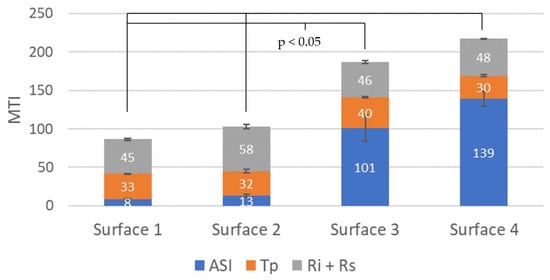
Figure 8.
MTI reported from 20 tests on each surface. All surfaces were statistically different expect from Surface 3 and 4.
3.2.6. Expert Panel Survey
Ten experts were recruited, with a combined 185 years’ experience in synthetic surfaces. They ranked the four surfaces as per Table 1, with the mean values calculated to produce the overall ranking.

Table 1.
Results from the expert review panel, describing their individual assessment of injury risk for each synthetic turf composition. The final ranking was determined by calculating the mean score for each surface.
3.2.7. MTI Validation
Directly comparing the blinded rankings of the expert panel with those of the MTI demonstrated the validity of this new methodology. The direct correlation evident in Figure 9 demonstrates successful validation, indicating strong measurement sensitivity.
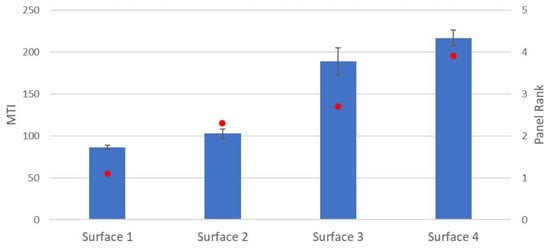
Figure 9.
The correlation between MTI scores (blue columns) and the expert panel ranking (red dots).
4. Discussion
A new apparatus has been produced that accurately represents the kinematics of an elite male player during a tackle scenario, recognised as the rugby event most likely to cause skin injury [38]. This device captures surface temperature, skin abrasion, and surface resistance, values that are compiled to form the MTI, a single measure of injury risk. The MTI has then been used to evaluate and rank four distinct 3G synthetic surfaces. The resultant ranking aligns with the consensus opinion of an expert panel, demonstrating the validity of this new methodology. The ANOVA (Supplementary Table S2) highlights that testing was most repeatable on Surface 4. Weaker repeatability was evident across Surfaces 1–3. This may be caused by the lower-volume, lighter infill of Surface 4 (15 mm cork infill), meaning that surface preparation was easier and more consistent across the four testing teams. It was not possible to conduct inferential statistics on the ASI scores, as each surface was tested only once. This is an area for future research.
Skin injury causation on synthetic surfaces has been historically associated with the generation of heat during sliding, producing burn-like trauma. Direct skin measurement would require immediate access to the skin surface, which, considering the distance slid and the impactor mass, proved impractical. Thermocouples embedded within the impactor reported unreliable data, recording significant fluctuations in temperature without any differences in other sliding metrics, whilst also inferring too frequent skin injury. Whilst measuring the surface temperature was a sub-optimal route to quantifying the thermal effect of sliding, the data were compared closely to those reported elsewhere using more direct methods [39]. The thermal camera detected significant differences across most of the 3G surfaces (Figure 4), with cork-based infills typically generating higher temperatures; however, the correlation between surface temperature, natural skin, and trauma remains unknown.
A novel approach is presented that quantifies skin abrasion via the ASI, incorporating areas of both obvious abrasion and less-severe material transfer. ASI data showed good repeatability, with small standard deviations across most surfaces (Figure 5). Past studies (e.g., Tay et al. [40]) have previously used the Securisport, which, given the above methodological limitations, prevents meaningful data comparison. The variation in ASI and, indeed, the damage to the skin simulant varied dramatically across the four surfaces and was particularly pronounced with the cork infill. The ASI was considered to accurately quantify these variations.
Quantifying surface resistance (Ri, Rs) provides additional insight into the deceleration profiles associated with each turf and each player–surface interaction. Ri describes the initial skin–surface contact, which is typically short in duration with minimal horizontal translation, as the impactor rebounds from the surface. Surfaces that generate high Ri are typically ineffective at absorbing energy due to having less elastic infill (and potentially different underlying shock pads, though a consistent composition was used throughout this study). This is consistent with Surfaces 1 and 3 having the greatest infill and producing the lowest Ri values (Figure 6), likely exposing the skin to the least stress during contact and resulting in minimal injury risk. Surface sliding resistance, Rs, is influenced by pile length, density, and the interaction with the infill. Achieving minimal resistance when sliding will likely minimise tension generated within the skin, which is also important in minimising injury risk. All the 3G surfaces exhibited comparable performance, as each had very similar exposed pile lengths. Third generation surfaces with greater pile lengths have previously been shown to be more resistant to sliding [40]. This underscores the importance of surface maintenance, especially considering that infill displacement is common.
This new methodology has been intentionally designed to replicate a generic player–surface interaction during an elite, male rugby tackle. Adopting a synthetic skin allows for repeatable testing, a requirement when establishing a new testing method. The obvious limitation, however, is that such an approach does not consider natural skin, nor does it encompass the range of skins and associated attributes of the many players this method is attempting to represent. Also, the kinematics do not encompass every sliding speed and load that are possible within a rugby tackle. The apparatus also has limitations, driven by the development of a design that can be integrated into existing test setups. The need to achieve representative sliding velocities necessitated a long apparatus, though this length was limited to comply with the dimensions of the existing wear testing protocols. These were assumed to be the maximum dimensions acceptable to potential adopters of this methodology, though this did mean that, in some instances, the impactor did not slide to rest. In such instances, accelerometer data were used to extrapolate a likely additional sliding distance, which was then incorporated into the appropriate measures. The variability in the impact deceleration results suggests Team 3 required additional training; however, the enhanced repeatability by the end of our study indicates that all teams became proficient in executing the test method.
5. Conclusions
This work has demonstrated the validity of the MTI in providing a novel methodology for assessing skin injury risk, by comparison to expert panel opinions. Scope exists for improved repeatability, which will form a key aspect of future work performed alongside experiments to establish an acceptable threshold for skin injury risk.
Supplementary Materials
The following supporting information can be downloaded at: https://www.mdpi.com/article/10.3390/lubricants12060207/s1, Table S1: Statistical analysis demonstrating device repeatability across the 4 Teams; Table S2: Statistical analysis differentiation between synthetic surfaces. Compiled MTI scores were then compared to the Expert Panel, to demonstrate validity.
Author Contributions
Conceptualization, E.O., E.H., M.D. and P.T.; Methodology, M.M. and P.T.; Validation, M.M.; Formal analysis, E.H. and N.L.; Investigation, M.M.; Resources, E.O.; Data curation, M.M.; Writing—original draft, M.M.; Writing—review & editing, E.O. and P.T.; Visualization, M.D.; Supervision, E.O. and P.T.; Project administration, P.T.; Funding acquisition, M.D. and P.T. All authors have read and agreed to the published version of the manuscript.
Funding
This work was funded by: World Rugby: G-1812-00195. The APC was funded by: Cardiff University.
Data Availability Statement
The data will be available via http://doi.org/10.17035/d.2024.0322557155 (accessed on 3 June 2024).
Conflicts of Interest
Maxwel MacFarlane’s PhD scholarship was part-sponsored by World Rugby, and Marc Douglas and Neale Lees are employed by World Rugby. World Rugby are motivated to expand rugby participation. Eric O’Donnell is employed by Sports Labs, who provide consultancy services to a range of clients including World Rugby. Eric Harrison is employed by Medici Construction Ltd., who provide consultancy services to a range of clients including World Rugby. The remaining author (PT) declares that the research was conducted in the absence of any commercial or financial relationship that could be construed as a potential conflict of interest.
References
- Gosnell, G.G.; Gerber, B.A.; Guyton, G.P.; Gould, H.P. Playing Surface and Injury Risk: Artificial Turf Vs. Natural Grass. Inj. Sports Med. 2022, 3, 1–18. [Google Scholar] [CrossRef]
- Sánchez-Sánchez, J.; Gallardo-Guerrero, A.M.; García-Gallart, A.; Sánchez-Sáez, J.A.; Felipe, J.L.; Encarnación-Martínez, A. Influence of the structural components of artificial turf systems on impact attenuation in amateur football players. Sci. Rep. 2019, 9, 7774. [Google Scholar] [CrossRef] [PubMed]
- Rugby, W. Regulation 22. Standard Relating to the Use of Rugby Turf. Available online: https://www.world.rugby/organisation/governance/regulations/reg-22 (accessed on 14 November 2023).
- Rugby, W. Rugby Turf Performance Specification. Available online: https://www.world.rugby/the-game/facilities-equipment/surfaces/performance-specification (accessed on 7 February 2024).
- Rugby, W. Year in Review 2021. Available online: http://publications.worldrugby.org/yearinreview2021/en/1-1 (accessed on 18 March 2023).
- Gould, H.P.; Lostetter, S.J.; Samuelson, E.R.; Guyton, G.P. Lower Extremity Injury Rates on Artificial Turf Versus Natural Grass Playing Surfaces: A Systematic Review. Am. J. Sports Med. 2023, 51, 1615–1621. [Google Scholar] [CrossRef]
- Reports, A. Global Artificial Grass Turf Industry Research Report 2023, Competitive Landscape, Market Size, Regional Status and Prospect. 2023. Available online: https://www.absolutereports.com/enquiry/request-sample/22362080?utm_source=23_LinkedIn (accessed on 7 February 2024).
- van den Eijnde, W. Skin Injury Due to Artificial Turf. The Skin as a Readout System 2017, Thesis—Radboud University Research Repository. Available online: https://repository.ubn.ru.nl/handle/2066/169051 (accessed on 7 February 2024).
- Burillo, P.; Gallardo, L.; Felipe, J.L.; Gallardo, A.M. Artificial turf surfaces: Perception of safety, sporting feature, satisfaction and preference of football users. Eur. J. Sport. Sci. 2014, 14 (Suppl. S1), S437–S447. [Google Scholar] [CrossRef] [PubMed]
- Roberts, J.R.; Osei-Owusu, P.; Mears, A.C.; Harland, A.R. Elite Players’ Perceptions of Football Playing Surfaces: A Qualitative Study. Res. Q. Exerc. Sport. 2020, 91, 239–251. [Google Scholar] [CrossRef] [PubMed]
- Williams, S.; Trewartha, G.; Kemp, S.P.T.; Michell, R.; Stokes, K.A.; Williams, S. The influence of an artificial playing surface on injury risk and perceptions of muscle soreness in elite Rugby Union. Scand. J. Med. Sci. Sports 2015, 26, 101–108. [Google Scholar] [CrossRef] [PubMed]
- Twomey, D.M.; Petrass, L.A.; Fleming, P.; Lenehan, K. Abrasion injuries on artificial turf: A systematic review. J. Sci. Med. Sport. 2019, 22, 550–556. [Google Scholar] [CrossRef] [PubMed]
- Shrestha, R.; Krishan, K.; Ishaq, H.; Kanchan, T.; Florida, A. Abrasion; StatPearls: Treasure Island, FL, USA, 2023. [Google Scholar]
- van den Eijnde, W.A.J.; Peppelman, M.; Lamers, E.A.D.; van de Kerkhof, P.C.M.; van Erp, P.E.J. Understanding the acute skin injury mechanism caused by player-surface contact during soccer: A survey and systematic review. Orthop. J. Sports Med. 2014, 2, 2325967114533482. [Google Scholar] [CrossRef] [PubMed]
- Basler, R.S.W.; Hunzeker, C.M.; Garcia, M.A. Athketic Skin Injuries: Combating Pressure and Friction. Physician Sportsmed. 2004, 32, 33–40. [Google Scholar] [CrossRef] [PubMed]
- Schwartz, C.J. Friction, Human Body: Skin. In Encyclopedia of Tribology; Wang, Q.J., Chung, Y.W., Eds.; Springer: Boston, MA, USA, 2013; pp. 1386–1393. [Google Scholar] [CrossRef]
- Derler, S.; Schrade, U.; Gerhardt, L.C. Tribology of human skin and mechanical skin equivalents in contact with textiles. Wear 2007, 263, 1112–1116. [Google Scholar] [CrossRef]
- Lagarde, J.M.; Rouvrais, C.; Black, D. Topography and anisotropy of the skin surface with ageing. Ski. Skin Res. Technol. 2005, 11, 110–119. [Google Scholar] [CrossRef] [PubMed]
- Li, L.; Mac-Mary, S.; Marsaut, D.; Sainthillier, J.M.; Nouveau, S.; Gharbi, T.; De Lacharrière, O.; Humbert, P. Age-related changes in skin topography and microcirculation. Arch. Dermatol. Res. 2006, 297, 412–416. [Google Scholar] [CrossRef] [PubMed]
- Tang, K.P.M.; Chau, K.H.; Kan, C.W.; Fan, J.T. Instrumental Evaluation of Stickiness of Textiles under Wet Skin Surface. IEEE Access 2018, 6, 24777–24792. [Google Scholar] [CrossRef]
- Tay, S.P.; Fleming, P.; Forrester, S.; Hu, X. Insights to skin-turf friction as investigated using the Securisport. Procedia Eng. 2015, 112, 320–325. [Google Scholar] [CrossRef]
- Lenehan, K.A.; Twomey, D.M. Abrasion testing on synthetic turf: A modified device. Proc. Inst. Mech. Eng. P. J. Sport. Eng. Technol. 2016, 230, 280–284. [Google Scholar] [CrossRef]
- Ekstrand, J.; Hägglund, M.; Fuller, C.W. Comparison of injuries sustained on artificial turf and grass by male and female elite football players. Scand. J. Med. Sci. Sports 2011, 21, 824–832. [Google Scholar] [CrossRef] [PubMed]
- Posthumus, L.; Macgregor, C.; Winwood, P.; Darry, K.; Driller, M.; Gill, N. Physical and fitness characteristics of elite professional rugby union players. Sports 2020, 8, 85. [Google Scholar] [CrossRef] [PubMed]
- Paul, L.; Naughton, M.; Jones, B.; Davidow, D.; Patel, A.; Lambert, M.; Hendricks, S. Correction: Quantifying Collision Frequency and Intensity in Rugby Union and Rugby Sevens: A Systematic Review. Sports Med.–Open 2022, 8, 12. [Google Scholar] [CrossRef] [PubMed]
- Van Den Eijnde, W.; Meijer, K.; Lamers, E.; Peppelman, M.; Van Erp, P. Exploring the biomechanical load of a sliding on the skin: Understanding the acute skin injury mechanism of player-surface interaction. J. Sports Med. Phys. Fit. 2017, 57, 1205–1210. [Google Scholar] [CrossRef] [PubMed]
- Schmitt, K.U.; Schlittler, M.; Boesiger, P. Biomechanical loading of the hip during side jumps by soccer goalkeepers. J. Sports Sci. 2010, 28, 53–59. [Google Scholar] [CrossRef] [PubMed]
- Rucker, R. Ranking the Top 5 Fastest Rugby Union Players in the World. Available online: https://www.ruck.co.uk/ranking-the-top-5-fastest-rugby-union-players-in-the-world/3/ (accessed on 13 November 2023).
- STATSports. Who Are the Fastest Players at the Rugby World Cup 2019? Available online: https://pro.statsports.com/who-are-the-fastest-players-at-rugby-world-cup-2019/ (accessed on 13 November 2023).
- HumanShape. Human Shape. Available online: http://humanshape.org/ (accessed on 14 November 2023).
- NASA. Anthropometry and Biomechanics. Available online: https://msis.jsc.nasa.gov/sections/section03.htm (accessed on 7 February 2024).
- FIFA. FIFA Quality Concept for Football Turf: Handbook of Test Methods. Available online: www.FIFA.com (accessed on 20 December 2023).
- MacFarlane, M.J.; Theobald, P. Skin tribology in sport. Biosurface Biotribol. 2021, 7, 113–118. [Google Scholar] [CrossRef]
- Cottenden, D.J.; Cottenden, A.M. A study of friction mechanisms between a surrogate skin (lorica soft) and nonwoven fabrics. J. Mech. Behav. Biomed. Mater. 2013, 28, 410–426. [Google Scholar] [CrossRef] [PubMed]
- Falloon, S.S.; Cottenden, A. Friction between a surrogate skin (Lorica Soft) and nonwoven fabrics used in hygiene products. Surf. Topogr. 2016, 4, 034010. [Google Scholar] [CrossRef]
- FIFA. FIFA Quality Programme for Football Turf: Handbook of Test Methods. No. October 2015. Available online: https://football-technology.fifa.com/media/1238/fqp-handbook-of-test-methods-v27.pdf (accessed on 7 February 2024).
- Martin, N.A.; Falder, S. A review of the evidence for threshold of burn injury. Burns 2017, 43, 1624–1639. [Google Scholar] [CrossRef] [PubMed]
- Mathewson, E.; Grobbelaar, R. Tackle-injury epidemiology in koshuis rugby players at Stellenbosch University. S. Afr. J. Sports Med. 2015, 27, 72–75. [Google Scholar] [CrossRef]
- Verhelst, R.; Rambour, S.; Verleysen, P.; Degrieck, J. Temperature development during sliding on different types of artificial turf for hockey. In Proceedings of the International Conference on Latest Advances in High-Tech Textiles and Textile-Based Materials, Ghent, Belgium, 23–25 September 2009; pp. 90–95. Available online: https://biblio.ugent.be/input/download?func=downloadFile&recordOId=767613&fileOId=767615 (accessed on 7 February 2024).
- Tay, S.P.; Fleming, P.; Hu, X.; Forrester, S. Skin friction related behaviour of artificial turf systems. J. Sports Sci. 2017, 35, 1500–1507. [Google Scholar] [CrossRef] [PubMed]
Disclaimer/Publisher’s Note: The statements, opinions and data contained in all publications are solely those of the individual author(s) and contributor(s) and not of MDPI and/or the editor(s). MDPI and/or the editor(s) disclaim responsibility for any injury to people or property resulting from any ideas, methods, instructions or products referred to in the content. |
© 2024 by the authors. Licensee MDPI, Basel, Switzerland. This article is an open access article distributed under the terms and conditions of the Creative Commons Attribution (CC BY) license (https://creativecommons.org/licenses/by/4.0/).